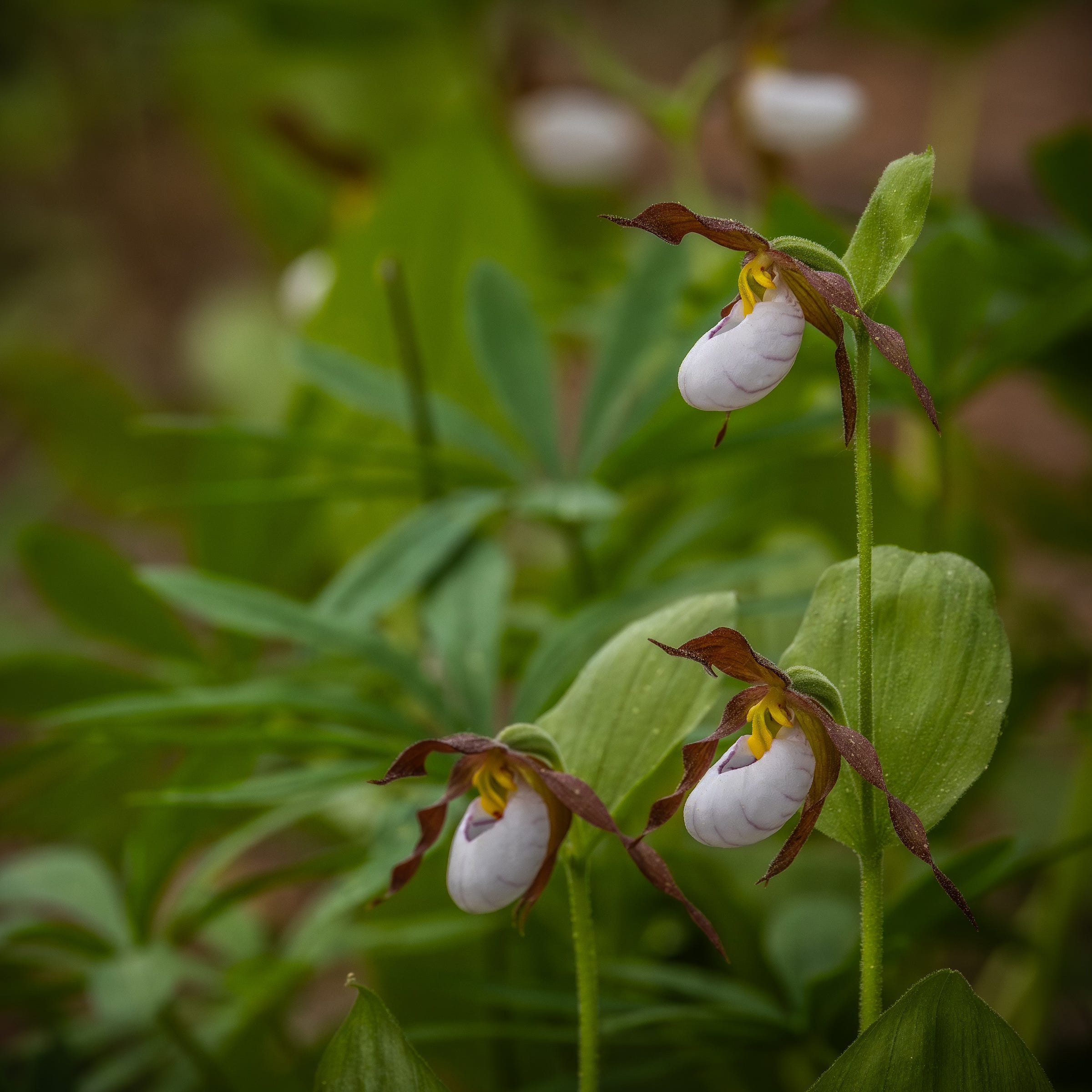The Yoda of Wildflowers
Cypripedium montanum. Padawan seeks apprenticeship with Lady's Slippers of the Northwest woods...

endosperm: noun BIOLOGY specialized, US /ˈen.doʊ.spɝːm/ the substance inside a plant seed that surrounds and provides food for the embryo as it develops.
If you are a seed, an embryonic plant born without endosperm you have a problem. Or so it would seem: how to survive and grow long enough to form absorbent roots and those leaves that will become your photosynthetic food factory. Absent endosperm, you need a friend.
Luckily, ten thousand generations ago, your great, great, great grandorchids (floral grandparents) formed an alliance, a mysterious friendship that has endured over eons. They joined forces with a type of fungus whose mycorrhizae would come find you in the vastness of woodland duff, pull nutrients from the soil and from the roots of other plants around them and deliver it to you. For reasons unexplained they do this for as long as a decade, through freezing winters and parched summers, caring for you, feeding and watering you in the dark, woodland soil until finally you are able to grow your own roots and push a single, tender, photosynthetic stem upward, piercing the soil’s surface and reaching, finally, sunlight.
Ten years is barely an eye blink in geologic time, but it is more than a lifetime for many birds, many mammals, amphibians and insects, including many people’s favorite pets. Ten years. A decade*. Think of it; all those thousands of nights and days while a fetal, Lady’s Slipper orchid has yet to even glimpse the light of day. In many worlds this sort of enduring feat would be considered a miracle. In fact, it is a miracle. And it demonstrates a level of cooperation and ‘intelligence,' a sentience if you will, that defies much of what I and perhaps many of you grew up believing about plants and fungi. It was animals who were the sentient ones, or so we were told. Plants were really no smarter than a pile of rocks.

Why would a plant evolve with seeds that cannot sustain their years-long, embryonic phase without help from some other life form? And just how do they, the ‘needy’ and the ‘helpers’ find one another? What’s in it for the fungus? Will the energetic debt eventually be repaid with interest once the Lady’s Slipper plant can photosynthesize? Ten years seems like a long time to wait, to keep serving, keep extending credit in the hopes of a ‘someday’ repayment. Modern capitalism almost always demands some sort of return far sooner.
So is it altruism? Can fungi give and forgive?
Can wildflower orchids repay a debt? Or shake on a deal?
All this points to a world of sophisticated relationships and cooperation that wildly exceeds anything most of us have ever yet suspected about flowering plants and fungal threads. But every year when I make my pilgrimage hundreds of miles to see and sit with these beings in their adult, flowering forms, I look once again into the heart of mystery. I quiet my breathing and fretful chatter to a place where I am once again, padawan and a flowering orchid in a dappled-sun (or dappled, moonlit), clearing …the venerable Yoda of wildflowers from whom I seek to learn even more about “the Force” which has been sustaining it (and me), for decades.
"…my ally is the Force, and a powerful ally it is. Life creates it, makes it grow. Its energy surrounds us and binds us. Luminous beings are we, not this crude matter. You Must Feel The Force Around You. Here. Between You, Me, The Tree, The Rock, Everywhere, Yes. Even Between The Land And The Ship." Jedi Grand Master Yoda - The Empire Strikes Back
That may all seem a bit more ‘Woo Woo’ than some of you can comfortably stomach. You’ll get no grief from me if that’s the case. But I would encourage you to simply sit quietly with a Cypripedium montanum one day, if you ever get the chance and see if you don’t come away with a sense that there’s something extra extraordiary about them, their physical presence and their long, slow, mysterious, cooperative life cycle.



Last year in early June I spent a night in the company of several Lady’s Slippers, making their portrait in the light of a full moon. I’ve included a link to that story, just below. This year the moon was obscured by heavy, rain clouds, so I spent hours huddled with several of them, and with other flowers in a steady rain that lasted most of a night and day.
They are still exquisite. Still unflappable. Still inexplicably mysterious and dare I say, wise? They are Yoda to my Padawan …or something like that.
Photographing Lady's Slippers In The Glow Of A Strawberry Moon
Words have their limits. Pictures, too. But put the two together and sometimes they can take us places, help us see and feel moments otherwise impossible to imagine. I have been awed by Lady’s Slippers for nearly twenty years, since my first encounter alongside a trail in the Oregon Cascades while backpacking in with a friend to fish remote stretches of…
(*I am told by those better acquainted with this seed-to-plant timeline that occasionally, some of these Lady’s Slipper Orchids may emerge in as few as three years, but that most take much longer, closer to ten. Even so, three years of ‘tending’ by one lifeform to another is kind of a wow in my book of natural wonders.)








Our pink lady slippers in MA need a bumblebee to be fertilized. So 3 species are working together.
In just a few words you've not only explained the science behind the life of an orchid, you've woven wonder, stillness, and beautiful photographs together to illuminate a breathtaking, mystical world. You make me want to head into the mountains immediately to find something, anything - a stream, a field of flowers, a boulder - to sit with and listen to.